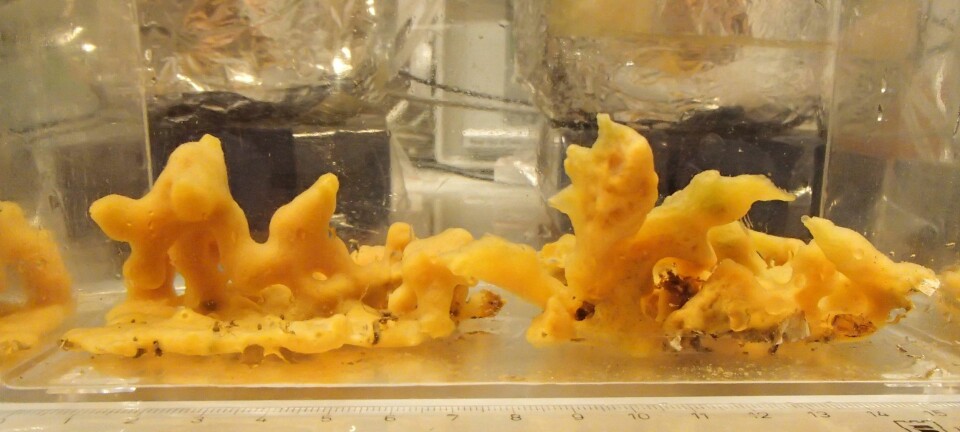
Scientists create crystals that absorb and store oxygen
New substance binds extremely concentrated quantities of oxygen, could have many uses as the oxygen can be released again when needed.
Scientists from the Department of Physics, Chemistry, and Pharmaceutics at the Southern University of Denmark have created a new substance that can absorb large quantities of oxygen -- and retain it for later release.
"We noticed how the substance absorbed oxygen from the air in the laboratory," says Professor Christine McKenzie. She’s behind the new discovery, alongside with postdoc Jonas Sundberg.
The substance is crystalline, and with the help of x-rays the scientists were able to study the constellation of atoms within the substance when it is full of oxygen and when it is empty of oxygen, respectively.
There is nothing surprising about the fact that a substance can absorb oxygen, in fact, a whole lot of substances absorb oxygen and react with it. Foods become rancid when exposed to oxygen, the taste of wine changes when it’s oxidised, and our bodies wouldn't function at all if our lungs couldn't inhale oxygen and exhale carbon dioxide.
"The very special thing about this substance is that it does not react irreversibly with the oxygen. It absorbs the oxygen and releases it again in a so-called selective chemisorption process. So the substance is a sort of sensor and container for oxygen and we can use it to store and transport oxygen," says McKenzie.
The core component of the new substance is the element cobalt, which is bound in a specially designed organic molecule.
"The cobalt gives the new substance precisely the molecular and electronic structure that enables it to absorb oxygen from its surroundings. We are familiar with this mechanism from every creature on Earth that breathes: we humans and many other species use iron, while other animals, such as crabs and spiders, use copper. The common denominator is that small quantities of metals are essential if they are to absorb and use oxygen, so it's not so peculiar that this effect can be seen in our new substance," McKenzie explains.
A bucketful is enough to empty all the oxygen from a room
The cobalt substance is pretty efficient when it comes to binding oxygen, so with around 10 litres you can absorb all the oxygen in a normal-sized room.
So far, McKenzie’s measurements suggest that the substance can absorb and bind oxygen in a concentration of 160 times that found in the air.
"Another interesting thing is that the substance can absorb and release oxygen many times without losing this capability. You can compare it with dipping a sponge into water, squeezing the water out of it, and repeating the process again and again," she says.
When the oxygen has been absorbed it can be stored in the substance until you need to release it. The scientists have observed exactly when this happens.
"Different types of impact cause the substance to release oxygen. These include heat and negative oxygen pressure. We saw it happen when we heated it up, and we also saw it happen when we surrounded it with a pressure lower than normal. It may also be possible to use light to trigger the release of oxygen from the substance -- that's something we would very much like to study," says McKenzie.
How the oxygen is released
It takes seconds, minutes, hours or days for the substance to absorb the oxygen around it, depending on the oxygen content, temperature, pressure, etc. of the air. Different variants of the substance bind oxygen at different speeds.
This opens up the potential for manufacturing a variety of apparatus which release or absorb oxygen under various circumstances -- for instance a mask that provides a person with oxygen without depriving them of oxygen.
"When the substance is saturated with oxygen one can compare it with a bottle containing compressed pure oxygen -- the difference is that our substance can contain three times as much oxygen," explains McKenzie.
She points out that a container of the substance will be much easier to carry than a heavy compressed oxygen bottle.
"For example lung patients who have to carry bottles of oxygen around. But also for divers, who can use this substance to absorb oxygen from the water that surrounds them. A couple of grains of the substance contain enough oxygen for one breath – and because the substance automatically absorbs oxygen from the water the diver wouldn’t need to bring much."
One could well imagine that this substance would be of interest to engineers developing hydrogen vehicles, which run on a mixture of hydrogen and oxygen. The substance was designed and produced at the University of Southern Denmark, while some of the gas measurements were done on special equipment by colleagues at the University of Sydney, Australia.
---------------
Read the original story in Danish on Videnskab.dk
Translated by: Hugh Matthews











